The AMD Ryzen 7 5700G, Ryzen 5 5600G, and Ryzen 3 5300G Review
by Dr. Ian Cutress on August 4, 2021 1:45 PM ESTMicrobenchmarks
Core-to-Core Latency
As the core count of modern CPUs is growing, we are reaching a time when the time to access each core from a different core is no longer a constant. Even before the advent of heterogeneous SoC designs, processors built on large rings or meshes can have different latencies to access the nearest core compared to the furthest core. This rings true, especially in multi-socket server environments.
But modern CPUs, even desktop and consumer CPUs, can have variable access latency to get to another core. For example, in the first-generation Threadripper CPUs, we had four chips on the package, each with 8 threads, and each with a different core-to-core latency depending on if it was on-die or off-die. This gets more complex with products like Lakefield, which has two different communication buses depending on which core is talking to which.
If you are a regular reader of AnandTech’s CPU reviews, you will recognize our Core-to-Core latency test. It’s a great way to show exactly how groups of cores are laid out on the silicon. This is a custom in-house test built by Andrei, and we know there are competing tests out there, but we feel ours is the most accurate to how quick an access between two cores can happen.
The Ryzen 7 5700G has the quickest thread-to-thread latency, however does offer a single slowest core-to-core latency. But compared to the 4000G series, having a single unified L3 cache reduces to core-to-core latency a good amount. The Ryzen 5 5300G has the slowest intracore latency, but the fastest average core-to-core.
Per-Core Power
One other angle to examine is how much power each core is drawing with respect to the rest of the chip. In this test, we run POV-Ray with a specific thread mask for a minute, and take a power reading 30 seconds into the test. We output the core power values from all cores, and compare them to the reported total package power.
The peak per-core power is shown as 15.2 W when one core is loaded on the Ryzen 7 5700G, and that comes down to ~8.8W when all cores are loaded. Interestingly this processor uses more power when six cores are loaded.
The Ryzen 5 5300G starts at 11.5 W for a single core, but then moves up to 12.3 W when three cores are loaded. It comes back down to 11.5 W when all four cores are loaded, but this ensures a consistent frequency (the 5300G has a 4.2 GHz Base and 4.4 GHz Turbo, explaining the small variation in loading).
Frequency Ramping
Both AMD and Intel over the past few years have introduced features to their processors that speed up the time from when a CPU moves from idle into a high-powered state. The effect of this means that users can get peak performance quicker, but the biggest knock-on effect for this is with battery life in mobile devices, especially if a system can turbo up quick and turbo down quick, ensuring that it stays in the lowest and most efficient power state for as long as possible.
Intel’s technology is called SpeedShift, although SpeedShift was not enabled until Skylake.
One of the issues though with this technology is that sometimes the adjustments in frequency can be so fast, the software cannot detect them. If the frequency is changing on the order of microseconds, but your software is only probing frequency in milliseconds (or seconds), then quick changes will be missed. Not only that, as an observer probing the frequency, you could be affecting the actual turbo performance. When the CPU is changing frequency, it essentially has to pause all compute while it aligns the frequency rate of the whole core.
We wrote an extensive review analysis piece on this, called ‘Reaching for Turbo: Aligning Perception with AMD’s Frequency Metrics’, due to an issue where users were not observing the peak turbo speeds for AMD’s processors.
We got around the issue by making the frequency probing the workload causing the turbo. The software is able to detect frequency adjustments on a microsecond scale, so we can see how well a system can get to those boost frequencies. Our Frequency Ramp tool has already been in use in a number of reviews.
In our test, the Ryzen 5 5600G jumps from 2700 to the turbo frequency in around a millisecond.


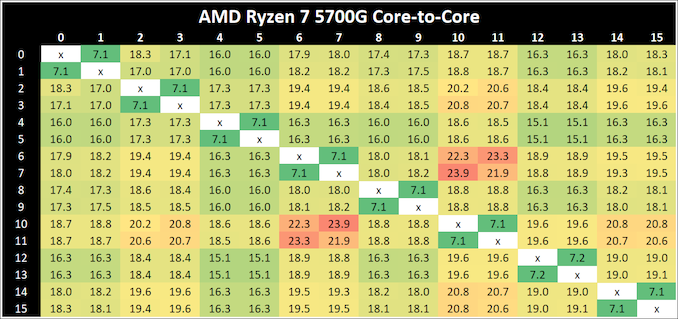
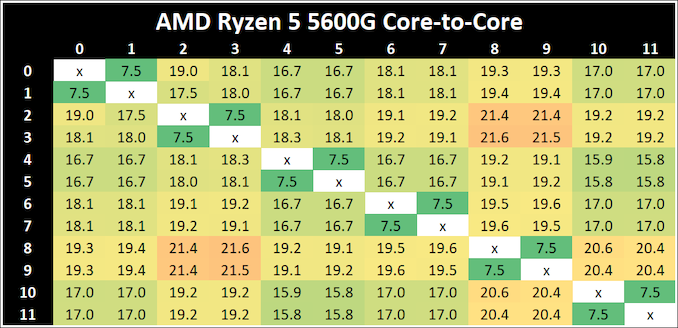
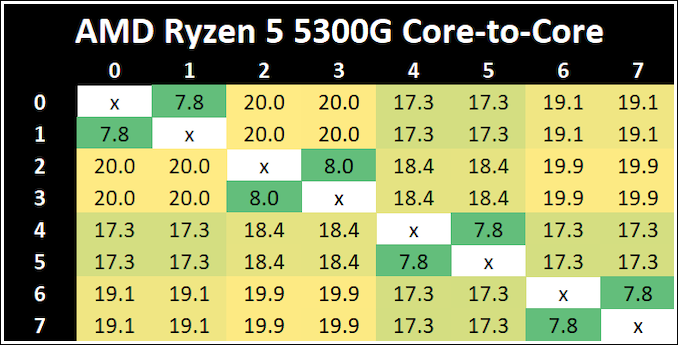
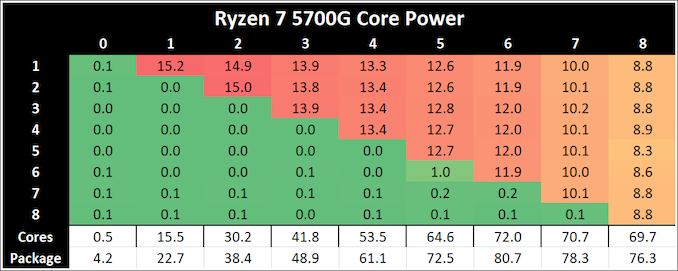

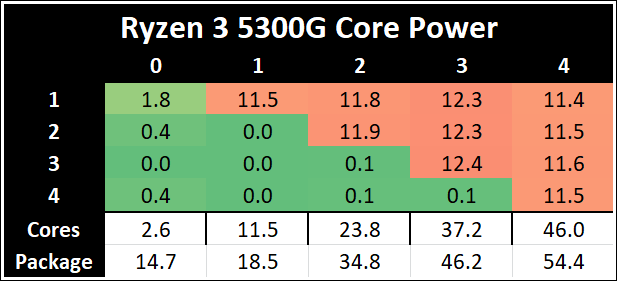
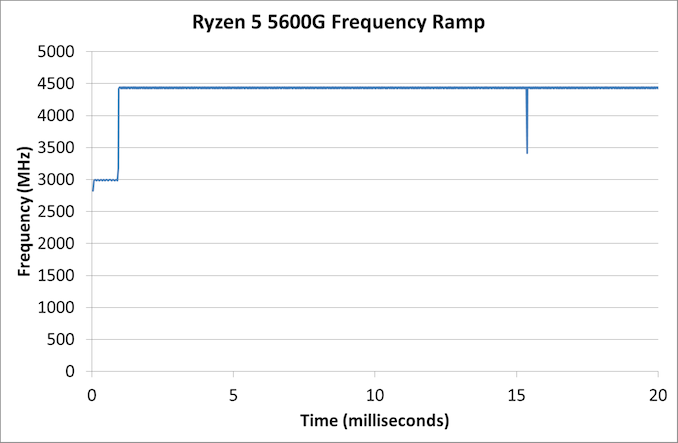








135 Comments
View All Comments
GeoffreyA - Thursday, August 5, 2021 - link
Yes, great follow-up article, that.nemi2 - Thursday, August 5, 2021 - link
Does anyone know if these 5x00G support 4k HDR, VVR, at 120Hz? I see some B550 MB advertise HDMI 2.1id4andrei - Thursday, August 5, 2021 - link
An overclocking section would be nice, with a focus on the iGPU only.Gasaraki88 - Thursday, August 5, 2021 - link
I'm worried about the performance of the Steam Deck.nandnandnand - Saturday, August 7, 2021 - link
https://videocardz.com/newz/steam-decks-rdna2-gpu-...Fulljack - Monday, August 9, 2021 - link
Steam Deck uses the much faster LPDDR5-5500 RAM and much powerful RDNA2 iGPU.mode_13h - Tuesday, August 10, 2021 - link
Yeah, but its iGPU is still 8 CUs. I think it's telling they went with 1280x800 resolution. Probably enough for a screen that size, and framerates are reportedly good.I do kinda wish they'd gone with a bigger iGPU, but maybe silicon prices these days pushed too hard against that. I think their goal should be to counter a plausible next-gen Nintendo Switch, and I'm not confident they got there.
Unlike Sony & MS, Valve can't afford to sell the hardware at a loss. The upside of that is that Valve isn't making it a walled garden. So, you should be able to load and run non-Steam software on it!
GreenReaper - Monday, August 16, 2021 - link
Compared to everything else in that form factor, it should be great. You probably won't be able to run most modern games at High and hit a solid 60FPS, or perhaps even 30FPS. But Medium might work. Meanwhile the competition is on Low with a few extra tweaks, and running games specifically designed for it (and likely costing a lot more). Heck, you might even be able to emulate them.The_Assimilator - Thursday, August 5, 2021 - link
Way too expensive, especially when you consider these chips lose out on PCIe 4.0 and are still using the ancient and terrible Vega.pman6 - Thursday, August 5, 2021 - link
i've used a prebuilt 5700G system, and for some reason, the Intel rocket lake runs smoother in certain applications like stock trading and java based apps.The only downside is that Intel is a power hog